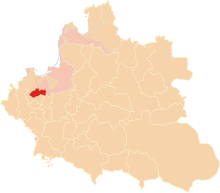Chełmno Voivodeship
| Chełmno Voivodeship Województwo chełmińskie Palatinatus Culmensis | |||||||||
|---|---|---|---|---|---|---|---|---|---|
| Voivodeship of Poland¹ Part of Royal Prussia and Greater Poland provinces | |||||||||
| 1454–1793 | |||||||||
 Chełmno Voivodeship of the Polish–Lithuanian Commonwealth (in 1619) | |||||||||
| Capital | Chełmno | ||||||||
| Area | |||||||||
• | 4,654 km2 (1,797 sq mi) | ||||||||
| History | |||||||||
• Established | 1454 | ||||||||
| 1466 | |||||||||
| 1569 | |||||||||
| 1772 | |||||||||
| 1793 | |||||||||
| Political subdivisions | Two lands divided into 7 counties | ||||||||
| |||||||||
| Today part of | Poland | ||||||||
| ¹ Voivodeship of the Polish Crown in the Polish–Lithuanian Commonwealth; Voivodeship of the Kingdom of Poland before 1569. | |||||||||
The Chełmno Voivodeship (Polish: Województwo chełmińskie) was a unit of administrative division and local government in the Kingdom of Poland since 1454/1466 until the Partitions of Poland in 1772/1793. Its capital was at Chełmno.
Together with the Pomeranian and Malbork Voivodeships and the Prince-Bishopric of Warmia it formed the province of Royal Prussia, and with several other voivodeships it formed the Greater Poland Province.
History
[edit]
The Chełmno Land (later known in German as Kulmerland) had been part of the Polish Duchy of Masovia since 1138. It was occupied by pagan Old Prussian tribes in 1216, who struggled against their Christianization instigated by Bishop Christian of Oliva. After several unsuccessful attempts to reconquer Chełmno, Duke Konrad I of Masovia in 1226 called for support by the Teutonic Knights, who indeed approached and started a Prussian campaign, after the duke promised to grant the Chełmno Land as a fief to the Teutonic Order.
In the course of the Order's decline after the 1410 Battle of Grunwald, the citizens of Chełmno, Toruń (Thorn), Lubawa (Löbau), Brodnica, Grudziądz, Nowe Miasto and Radzyń co-formed the anti-Teutonic Prussian Confederation. In 1454, the organisation led an uprising against the rule of the Teutonic Knights, and asked King Casimir IV of Poland to reincorporate the region to the Kingdom of Poland, to which the King agreed and signed the act of reincorporation,[1] which sparked the Thirteen Years' War between the Knights and the Kingdom of Poland. The towns and nobles of the region then took an oath of allegiance to Poland in Toruń in May 1454.[2] The Chełmno Voivodeship was established the same year. After the Order's defeat, the reintegration of Chełmno Land with Poland was confirmed in the Second Peace of Thorn and together with the adjacent Lubawa Land in the east it formed the Chełmno Voivodeship of the Polish Crown, since the 1569 Union of Lublin part of the Polish–Lithuanian Commonwealth.
The voivodeship was annexed by Prussia during the First Partition of Poland in 1772, except for the city of Toruń, which was not incorporated into the province of West Prussia until the 1793 Second Partition.
Administration
[edit]
Voivodeship Governor (Wojewoda) seat:
Regional council (sejmik generalny)
Regional councils (sejmik poselski i deputacki)
Administrative division:
- Chełmno Land, (Ziemia Chełmińska), Chełmno
- Chełmno County, (Powiat Chełmiński), Chełmno
- Toruń County, (Powiat Toruński), Toruń
- Grudziądz County, (Powiat Grudziądzki), Grudziądz
- Radzyń County, (Powiat Radzyński), Radzyń
- Kowalewo County, (Powiat Kowalewski), Kowalewo
- Michałowo Land, (Ziemia Michałowska), Lubawa
- Brodnica County, (Powiat Brodnicki), Brodnica
- Nowe Miasto County, (Powiat Nowomiejski), Nowe Miasto Lubawskie
Cities and towns
[edit]

The largest city of the voivodeship was the royal city of Toruń,[3] which as one of the largest and most influential cities of entire Poland enjoyed voting rights during the Royal free elections.[4] Other royal cities and towns were Brodnica, Golub, Grudziądz, Kowalewo, Lidzbark, Łasin, Nowe Miasto, Radzyń, Rogoźno, whereas private church towns were Chełmno, Chełmża, Kurzętnik, Lubawa and Wąbrzeźno.[3]
Voivodes
[edit]
- Augustyn z Szewy, 1454–1455
- Gabriel Bażyński, 1455–1474
- Ludwik Mortęski, 1475–1480
- Mikołaj Dąbrowski, 1480–1483
- Karol z Napola, 1484–1495
- Jan Dąbrowski, 1498–1513
- Jan Luzjański, 1514–1551
- Stanisław Kostka, 1551–1555
- Jan Działyński, 1556–1583
- Mikołaj Działyński, 1584–1604
- Maciej Konopacki, 1605–1611
- Ludwik Mortęski, 1611–1615
- Stanisław Działyński, 1615-1615
- Jan Jakub Wejher, 1618–1626
- Melchior Wejher, 1626–1643
- Mikołaj Wejher, 1643–1647
- Jan Działyński, 1647–1648
- Jan Kos, 1648–1662
- Piotr Działyński, 1663–1668
- Jan Gniński, 1668–1680
- Michał Działyński, 1681–1687
- Jan Kos (died 1702),1688–1702
- Tomasz Działyński, 1702–1714
- Jakub Zygmunt Rybiński, 1714–1725
- Franciszek Bieliński, 1725–1732
- Jan Ansgary Czapski 1732–1738
- Michał Wiktor Bieliński, 1738–1746
- Zygmunt Kretkowski, 1746–1766
- Franciszek Stanisław Hutten-Czapski, 1766–1802
References
[edit]- ^ Górski, Karol (1949). Związek Pruski i poddanie się Prus Polsce: zbiór tekstów źródłowych (in Polish). Poznań: Instytut Zachodni. p. 54.
- ^ Górski, p. 76
- ^ a b Prusy Królewskie w drugiej połowie XVI wieku. Część I. Mapy, plany (in Polish). Warszawa: Instytut Historii Polskiej Akademii Nauk. 2021. p. 1.
- ^ Polska encyklopedja szlachecka, Tom I (in Polish). Warszawa: Wydawnictwo Instytutu Kultury Historycznej. 1935. p. 42.


